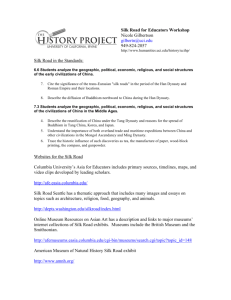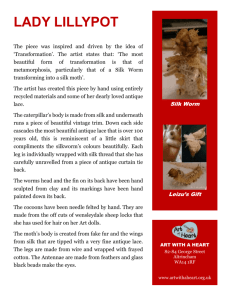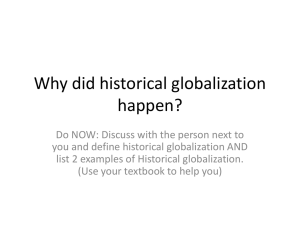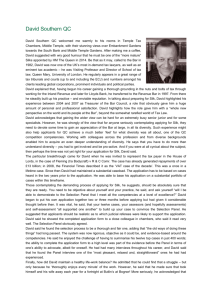Using Primary Sources to Teach the Silk Road
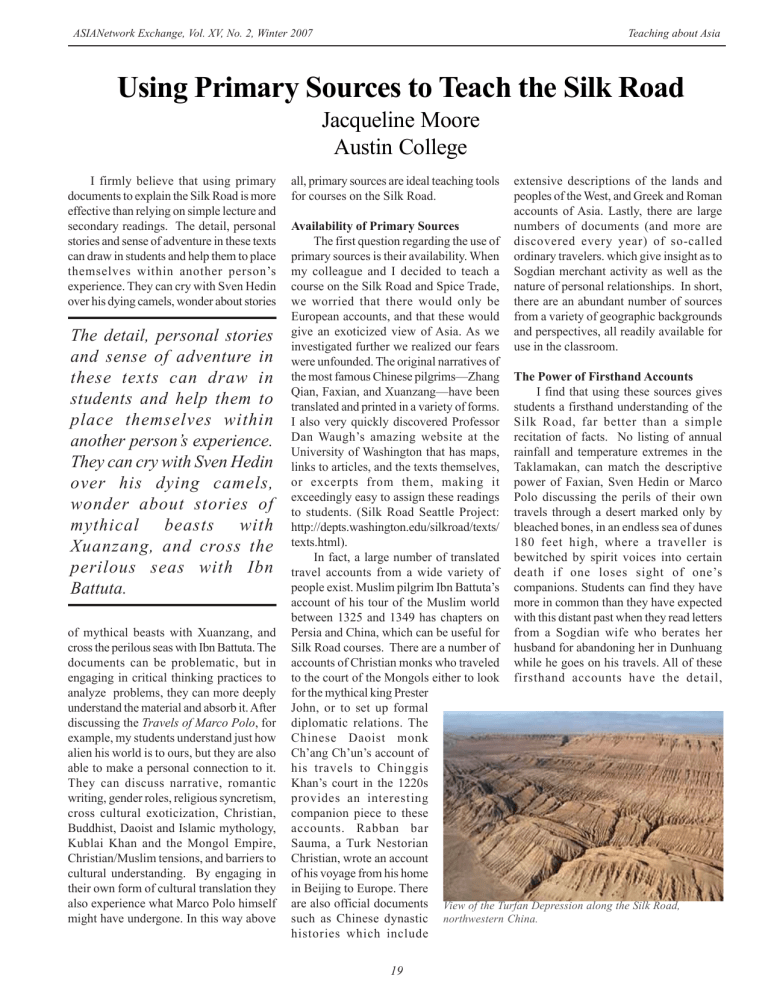
ASIANetwork Exchange, Vol. XV, No. 2, Winter 2007 Teaching about Asia
Using Primary Sources to Teach the Silk Road
Jacqueline Moore
Austin College
I firmly believe that using primary documents to explain the Silk Road is more effective than relying on simple lecture and secondary readings. The detail, personal stories and sense of adventure in these texts can draw in students and help them to place themselves within another person’s experience. They can cry with Sven Hedin over his dying camels, wonder about stories
The detail, personal stories and sense of adventure in these texts can draw in students and help them to place themselves within another person’s experience.
They can cry with Sven Hedin over his dying camels, wonder about stories of mythical beasts with
Xuanzang, and cross the perilous seas with Ibn
Battuta.
of mythical beasts with Xuanzang, and cross the perilous seas with Ibn Battuta. The documents can be problematic, but in engaging in critical thinking practices to analyze problems, they can more deeply understand the material and absorb it. After discussing the Travels of Marco Polo, for example, my students understand just how alien his world is to ours, but they are also able to make a personal connection to it.
They can discuss narrative, romantic writing, gender roles, religious syncretism, cross cultural exoticization, Christian,
Buddhist, Daoist and Islamic mythology,
Kublai Khan and the Mongol Empire,
Christian/Muslim tensions, and barriers to cultural understanding. By engaging in their own form of cultural translation they also experience what Marco Polo himself might have undergone. In this way above all, primary sources are ideal teaching tools for courses on the Silk Road.
Availability of Primary Sources
The first question regarding the use of primary sources is their availability. When my colleague and I decided to teach a course on the Silk Road and Spice Trade, we worried that there would only be
European accounts, and that these would give an exoticized view of Asia. As we investigated further we realized our fears were unfounded. The original narratives of the most famous Chinese pilgrims—Zhang
Qian, Faxian, and Xuanzang—have been translated and printed in a variety of forms.
I also very quickly discovered Professor
Dan Waugh’s amazing website at the
University of Washington that has maps, links to articles, and the texts themselves, or excerpts from them, making it exceedingly easy to assign these readings to students. (Silk Road Seattle Project: http://depts.washington.edu/silkroad/texts/ texts.html).
In fact, a large number of translated travel accounts from a wide variety of people exist. Muslim pilgrim Ibn Battuta’s account of his tour of the Muslim world between 1325 and 1349 has chapters on
Persia and China, which can be useful for
Silk Road courses. There are a number of accounts of Christian monks who traveled to the court of the Mongols either to look for the mythical king Prester
John, or to set up formal diplomatic relations. The
Chinese Daoist monk
Ch’ang Ch’un’s account of his travels to Chinggis
Khan’s court in the 1220s provides an interesting companion piece to these accounts. Rabban bar
Sauma, a Turk Nestorian
Christian, wrote an account of his voyage from his home in Beijing to Europe. There are also official documents such as Chinese dynastic histories which include extensive descriptions of the lands and peoples of the West, and Greek and Roman accounts of Asia. Lastly, there are large numbers of documents (and more are discovered every year) of so-called ordinary travelers. which give insight as to
Sogdian merchant activity as well as the nature of personal relationships. In short, there are an abundant number of sources from a variety of geographic backgrounds and perspectives, all readily available for use in the classroom.
The Power of Firsthand Accounts
I find that using these sources gives students a firsthand understanding of the
Silk Road, far better than a simple recitation of facts. No listing of annual rainfall and temperature extremes in the
Taklamakan, can match the descriptive power of Faxian, Sven Hedin or Marco
Polo discussing the perils of their own travels through a desert marked only by bleached bones, in an endless sea of dunes
180 feet high, where a traveller is bewitched by spirit voices into certain death if one loses sight of one’s companions. Students can find they have more in common than they have expected with this distant past when they read letters from a Sogdian wife who berates her husband for abandoning her in Dunhuang while he goes on his travels. All of these firsthand accounts have the detail,
View of the Turfan Depression along the Silk Road, northwestern China.
19
Teaching about Asia ASIANetwork Exchange, Vol. XV, No. 2, Winter 2007 characters, plot and humor that can draw in students and raise their interest level more than by giving them dry facts.
Document Authenticity
Yet there are a number of problems with using these sources aside from the usual need for editing for coherence and consistency, and creating targeted reading questions. The first problem is the reliability of the documents. In many cases there are only varied copies of original sources, and it is not possible to find a definitive version. In at least one case, a
Chinese emperor, unsatisfied with the length of a document he asked a scholar to copy, simply told him to add more information to it. The Chinese historians also tended to just copy their information almost word for word from earlier sources, assuming that the West was unchanging.
Marco Polo’s narrative was written by a romance writer he met in prison six years after his return and it is not clear what parts of the narrative were Marco’s words and which parts the writer added. It is also not clear how much Marco made up or other people have added over the years. One historian has even suggested that Marco
Polo never actually visited China in person, and it is clear that in at least some sections he was simply reporting what he had heard of a place. But the solution to these problems is again to draw attention to them and encourage students to think about the way history is constructed, as they learn to appreciate the fact that documents are not always reliable narrators of events.
Issues of Translation
Second there is the problem of translation: literal, cultural and chronological. Since almost all the documents were not originally in English there is the obvious linguistic problem of how to translate specific words. The travellers may have faced similar problems in translating information. In the case of the Chinese accounts, the information itself might have been translated by a third party: a Gujarati sailor arriving at the Chinese court might speak Malay but not Chinese, and would have required a Malay-Chinese interpreter, for example. It could be like a game of “telephone” that children play at parties with a sentence becoming unintelligible as it travels from one person to the next. Xuanzang himself undertook his pilgrimage to India to find original
Buddhist texts as he believed that Buddhist doctrine had become corrrupted over the years through poor translations.
Literal translation is not the only problem. When Marco Polo reports that husbands in Kamul encourage their houseguests to sleep with their wives as part of their hospitality we recognize some potential cultural dissonance at work. Was this really the practice or did he misinterpret? Was the woman perhaps a prostitute? Was it just one household in which the wife decided she wanted to sleep with the young exotic Italian? Or did the local citizens cooperate out of fear of
European military prowess? This issue of cultural translation provides a golden opportunity in the classroom. A discussion of sexual behavior in Kamul might reveal a lot about gender roles along the Silk Road
(certainly it is one of the few places you get to discuss women’s actions), and it certainly can serve as a reminder not to take each story literally.
Document Interpretation
Novelist L. P. Hartley wrote “The Past is a foreign country.” This concept is perhaps the hardest one for students to understand when using historical documents. In Silk Road sources, miracles and magic abound. Faxian explains that a sculpture of the Maitreya Buddha is accurate because the author went up to
Tushita heaven and met with him, and
Marco Polo tells the story of a church that miraculously levitated when the Muslims came to take a stone from under its central pillar. The students (and my) first reaction upon reading these stories, is to immediately come up with a scientific explanation for these miracles. The artist had a dream he went to heaven; the stone was not really supporting the central pillar when they took it. Of course, as I tell my students, the point is not whether or not these things actually happened. What is the point is that it is nearly impossible for us to understand what these travelers saw unless we recognize that they lived in a world where they believed these things were possible.
The issue of linguistic and cultural translation is a metaphor for the Silk Road itself. After all, both ideas and goods were traded along the road through a continuous process of translation. Indeed the metaphor of “telephone” is one I use continuously when I talk about the transmission of
20
Indeed the metaphor of
“telephone” is one I use continuously when I talk about the transmission of
Buddhism, Christianity or
Islam throughout Eurasia.
Making students aware of their own cultural biases in reading documents can help them better understand what it must have been like for the travelers themselves.
Buddhism, Christianity or Islam throughout
Eurasia. Making students aware of their own cultural biases in reading documents can help them better understand what it must have been like for the travelers themselves. And getting students to step out of their own experience, both geographically and chronologically, is key to understanding the Silk Road. Ultimately, by using primary sources in the classrom you can start to recreate the Silk Road experience itself.
Favorites:
2) Ancient Sogdian letters http://depts.washington.edu/silkroad/texts/ sogdlet.html
Great for personalities and day-to-day life on the Silk Road. Everyone loves the
Sogdians.
Appendix
Jackie Moore’s Top Five Pre-1500
1) Selections from the Han Narrative
Histories http://artemis.austincollege.edu/acad/ h i s t o r y / j m o o r e / S y l l a b i / H W C 2 2
S i l k S p i c e s / S e l e c t i o n F r o m T h e H a n
NarrativeHistories.html
Originally digitized at Silk Road Seattle, edited with standardized spellings and place names by J. Moore. Good account of Zhang Qian’s journey and foreign relations but a little like a catalogue sometimes. Assign with targeted questions to aid in reading.
(continued on page 30)
Network News ASIANetwork Exchange, Vol. XV, No. 2, Winter 2007
Rhodes College
John F. Copper, Professor of
International Studies, published Taiwan’s
2006 Metropolitan Mayoral and City
Council Elections and the Politics of
Corruption in University of Maryland
School of Law’s Maryland Series in
Contemporary Asian Studies.
Sewanee: The University of the South
D-Day in the Pacific: The Battle of
Saipan (Indiana University Press, 2007), by Harold Goldberg, Chair of the Asian
Studies Program, is now a featured choice for History Book Club and Military Book
Club. The book also includes maps by
Daniel S. Backlund of Sewanee’s Theatre
Department.
University of Redlands
Karen Derris (Religious Studies) and Anne Cavender (English), members of the Asian Studies Program Advisory
Group, received tenure and were promoted to associate professor.
Why Teach the Silk Road?
(continued from page 18) porcelain, whereas the Chinese needed little that Britain could offer.
Importance of the Silk Road
Why is the Silk Road important? I have taught courses on the Silk Road twice, and the response of one student on an end-of-term course evaluation sums the situation up very effectively: “I had no idea.” Such a course not necessarily the ones that I taught, but one that has in some way been generated by the Silk
Road—offers a more globablized view of the world that is far more appropriate at the beginning of the 21st century than the more Eurocentric view with which most of us were raised.
Another reason that studying the Silk
Road is important is because students, like most Americans, have been so taken by surprise by China’s recent economic resurgence. The past fifty years or so have taught them to think of China in terms of
Mao’s Communist Revolution, the Cold
War, the Great Leap Forward, the Cultural
Revolution, Tiananmen Square, and so on.
The China of the past decade, which has seen its modernization, the rise of capitalism and increasing dominance of world markets, and its new openness as
Beijing looks forward to hosting the 2008
Summer Olympic Games—is startling to them, and perhaps puzzling, as well. An understanding of China’s prominence in world economic markets over the preceding two millennia will put events of the past ten years, and the preceding fifty, into a valuable historical context, shedding light on both time periods.
Using Primary Sources to Teach the Silk Road
(continued from page 20)
3) Xuanzang’s Account http://depts.washington.edu/silkroad/ texts/xuanzang.html
Book 1 only with a cosmological description of the world and a catalog of countries mixed in with some stories. Nice description of Balkh, Bamiyan and Kapisa but pick and choose excerpts otherwise.
The full account is available either as The
Great Tang Dynasty Record of Western
Regions or Si Yu Ki: Buddhistic Records
of the Western World by “Hiuen Tsang”.
However Journey to the West is a fictionalized version of Xuanzang’s travels with two versions available, one by Anthony Yu and another by W. J F.
Jenner. Yu’s is supposed to be more faithful to the original language; Jenner’s is more poetic from an English language standpoint. Journey to the West is itself 4 vols long and many prefer to have an abridged version called Monkey, by Arthur
Waley which is back in print. There are two other abbreviated versions: Aaron
Sheperd’s Monkey: A Superhero Tale of
China which is a children’s book, and
David Kherdian’s Monkey: A Journey To
the West which seems to have edited it down to the best action scenes.
4) Accounts of Mongols
Travels of Ch’ang Ch’un to the West http://depts.washington.edu/silkroad/ texts/changchun.html
Starts with really nice letter of invitation from Chinggis Khan and Ch’ang Ch’un is a DAOIST Monk! 21 pages. Really good descriptions of Mongol life pairs well with:
John Pian de Carpine’s Account http://depts.washington.edu/silkroad/ texts/carpini.html
10 pages, with a great storyline and good images. and
William of Rubruck’s Account http://depts.washington.edu/silkroad/ texts/rubruck.html
Dan Waugh’s Silk Road Seattle has 63 pages, nicely bookmarked by topic.
Really good descriptions of Mongol daily life and shows how cosmopolitan
Karakorum was as well as the influence of Nestorians
John Pian de Carpine’s account was originally published with William of
30
Rubrick’s and you can get them in a package deal: Rana Saad, William of
Rubruck’s Account of the Mongols. The version by Peter Jackson, trans., The
Mission of Friar William of Rubruck, which is supposed to be the definitive translation with the best annotations, is unfortunately out of print.
5) Ruy Gonzales di Cavilo’s Account http://depts.washington.edu/silkroad/ texts/clavijo/cltxt1.html
The King of Castile sent him to Timur’s
(Tamerlane’s) court in Samarkand. He has great descriptions of Timur and the book is easy to read, as it includes lush detail as well as good travel information. 31 pages on Dan Waugh’s site.
Lastly, one favorite modern account from the Great Game period:
Sven Hedin, My Life as an Explorer, 560 pp. Listed as one of National
Geographic’s top travel adventures of all time. Be thrilled as Sven races through the desert, stealing artifacts, as one by one his men and a succession of horses, donkeys and camels fall prey to the elements or to bandits.




